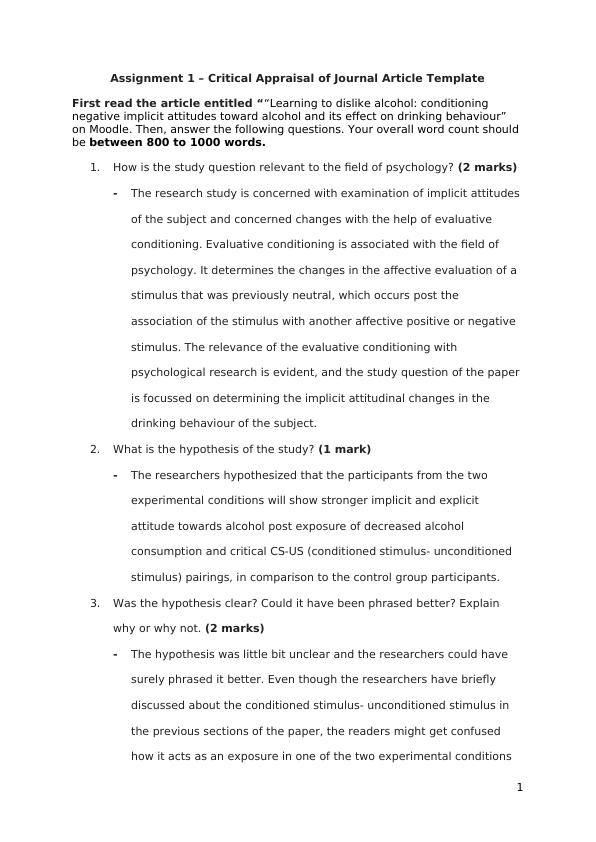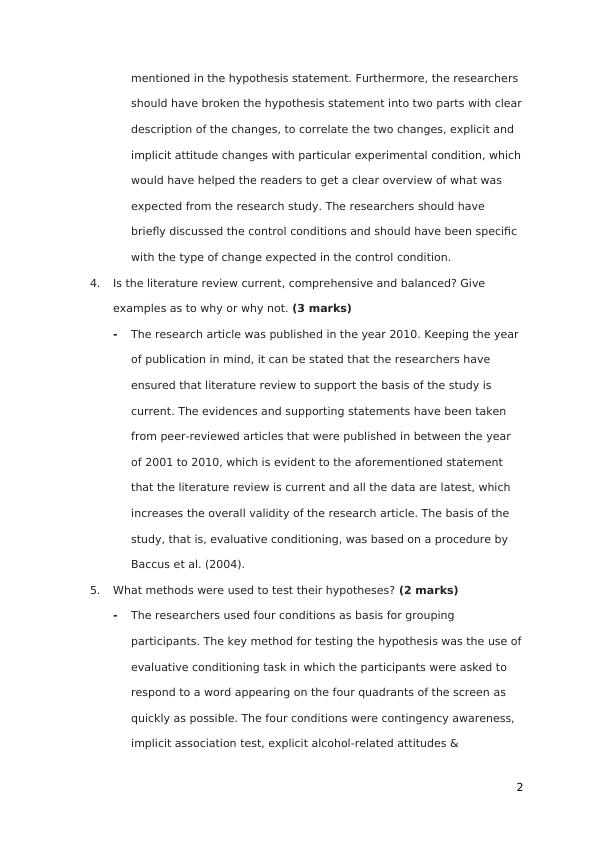Learning to dislike alcohol: conditioning negative implicit attitudes toward alcohol and its effect on drinking behaviour
4 Pages1123 Words299 Views
Added on 2022-07-28
About This Document
word limit is 1000 including the questions.
Learning to dislike alcohol: conditioning negative implicit attitudes toward alcohol and its effect on drinking behaviour
Added on 2022-07-28
ShareRelated Documents
Assignment 1 – Critical Appraisal of Journal Article Template
First read the article entitled ““Learning to dislike alcohol: conditioning
negative implicit attitudes toward alcohol and its effect on drinking behaviour”
on Moodle. Then, answer the following questions. Your overall word count should
be between 800 to 1000 words.
1. How is the study question relevant to the field of psychology? (2 marks)
- The research study is concerned with examination of implicit attitudes
of the subject and concerned changes with the help of evaluative
conditioning. Evaluative conditioning is associated with the field of
psychology. It determines the changes in the affective evaluation of a
stimulus that was previously neutral, which occurs post the
association of the stimulus with another affective positive or negative
stimulus. The relevance of the evaluative conditioning with
psychological research is evident, and the study question of the paper
is focussed on determining the implicit attitudinal changes in the
drinking behaviour of the subject.
2. What is the hypothesis of the study? (1 mark)
- The researchers hypothesized that the participants from the two
experimental conditions will show stronger implicit and explicit
attitude towards alcohol post exposure of decreased alcohol
consumption and critical CS-US (conditioned stimulus- unconditioned
stimulus) pairings, in comparison to the control group participants.
3. Was the hypothesis clear? Could it have been phrased better? Explain
why or why not. (2 marks)
- The hypothesis was little bit unclear and the researchers could have
surely phrased it better. Even though the researchers have briefly
discussed about the conditioned stimulus- unconditioned stimulus in
the previous sections of the paper, the readers might get confused
how it acts as an exposure in one of the two experimental conditions
1
First read the article entitled ““Learning to dislike alcohol: conditioning
negative implicit attitudes toward alcohol and its effect on drinking behaviour”
on Moodle. Then, answer the following questions. Your overall word count should
be between 800 to 1000 words.
1. How is the study question relevant to the field of psychology? (2 marks)
- The research study is concerned with examination of implicit attitudes
of the subject and concerned changes with the help of evaluative
conditioning. Evaluative conditioning is associated with the field of
psychology. It determines the changes in the affective evaluation of a
stimulus that was previously neutral, which occurs post the
association of the stimulus with another affective positive or negative
stimulus. The relevance of the evaluative conditioning with
psychological research is evident, and the study question of the paper
is focussed on determining the implicit attitudinal changes in the
drinking behaviour of the subject.
2. What is the hypothesis of the study? (1 mark)
- The researchers hypothesized that the participants from the two
experimental conditions will show stronger implicit and explicit
attitude towards alcohol post exposure of decreased alcohol
consumption and critical CS-US (conditioned stimulus- unconditioned
stimulus) pairings, in comparison to the control group participants.
3. Was the hypothesis clear? Could it have been phrased better? Explain
why or why not. (2 marks)
- The hypothesis was little bit unclear and the researchers could have
surely phrased it better. Even though the researchers have briefly
discussed about the conditioned stimulus- unconditioned stimulus in
the previous sections of the paper, the readers might get confused
how it acts as an exposure in one of the two experimental conditions
1

mentioned in the hypothesis statement. Furthermore, the researchers
should have broken the hypothesis statement into two parts with clear
description of the changes, to correlate the two changes, explicit and
implicit attitude changes with particular experimental condition, which
would have helped the readers to get a clear overview of what was
expected from the research study. The researchers should have
briefly discussed the control conditions and should have been specific
with the type of change expected in the control condition.
4. Is the literature review current, comprehensive and balanced? Give
examples as to why or why not. (3 marks)
- The research article was published in the year 2010. Keeping the year
of publication in mind, it can be stated that the researchers have
ensured that literature review to support the basis of the study is
current. The evidences and supporting statements have been taken
from peer-reviewed articles that were published in between the year
of 2001 to 2010, which is evident to the aforementioned statement
that the literature review is current and all the data are latest, which
increases the overall validity of the research article. The basis of the
study, that is, evaluative conditioning, was based on a procedure by
Baccus et al. (2004).
5. What methods were used to test their hypotheses? (2 marks)
- The researchers used four conditions as basis for grouping
participants. The key method for testing the hypothesis was the use of
evaluative conditioning task in which the participants were asked to
respond to a word appearing on the four quadrants of the screen as
quickly as possible. The four conditions were contingency awareness,
implicit association test, explicit alcohol-related attitudes &
2
should have broken the hypothesis statement into two parts with clear
description of the changes, to correlate the two changes, explicit and
implicit attitude changes with particular experimental condition, which
would have helped the readers to get a clear overview of what was
expected from the research study. The researchers should have
briefly discussed the control conditions and should have been specific
with the type of change expected in the control condition.
4. Is the literature review current, comprehensive and balanced? Give
examples as to why or why not. (3 marks)
- The research article was published in the year 2010. Keeping the year
of publication in mind, it can be stated that the researchers have
ensured that literature review to support the basis of the study is
current. The evidences and supporting statements have been taken
from peer-reviewed articles that were published in between the year
of 2001 to 2010, which is evident to the aforementioned statement
that the literature review is current and all the data are latest, which
increases the overall validity of the research article. The basis of the
study, that is, evaluative conditioning, was based on a procedure by
Baccus et al. (2004).
5. What methods were used to test their hypotheses? (2 marks)
- The researchers used four conditions as basis for grouping
participants. The key method for testing the hypothesis was the use of
evaluative conditioning task in which the participants were asked to
respond to a word appearing on the four quadrants of the screen as
quickly as possible. The four conditions were contingency awareness,
implicit association test, explicit alcohol-related attitudes &
2

End of preview
Want to access all the pages? Upload your documents or become a member.
Related Documents
Article Reviewlg...
|5
|907
|176
